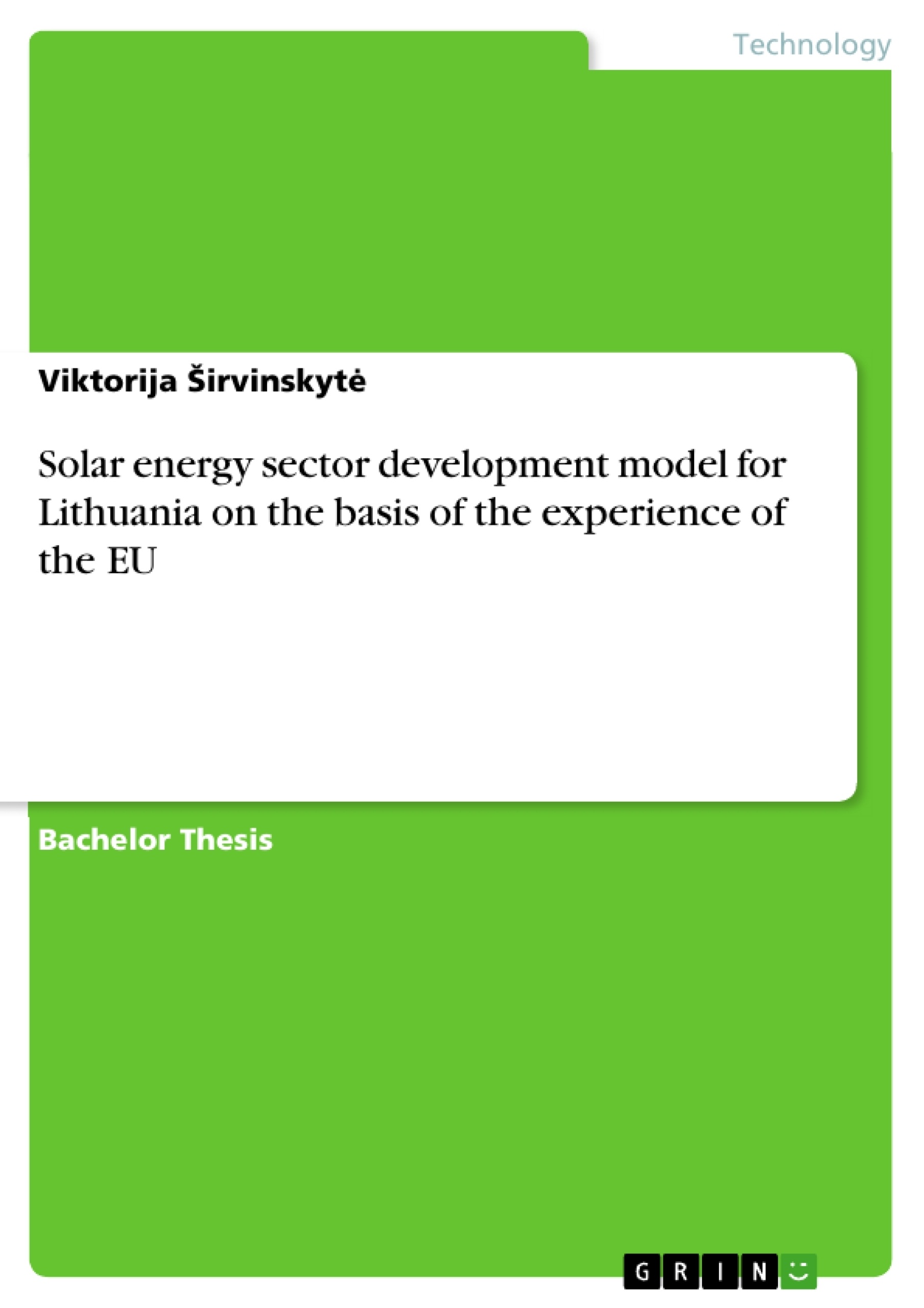Due to the renewable energies nowadays being of a great relevance in the European Union and recent solar energy sector issues in Lithuania and its relevance to investors and the country, the aim of this bachelor thesis is to create a model that would suggest the measures, actions, improvements for the solar energy sector of Lithuania in order to promote a better development of the sector and achieve more effective results, improve the current situation and future prospects of the solar energy sector in Lithuania and increase the attractiveness of investing in it.
Inhaltsverzeichnis (Table of Contents)
- INTRODUCTION
- 1. THE RELEVANCE OF THE SOLAR ENERGY SECTOR
- 1.1. Securing the energy supply.
- 1.2. Effect to the Economy
- 1.3. Protecting the environment.
- 1.4. Solar energy technologies.
- 1.5. The energy production..
- 1.6. The use of the energy..
- 1.7. Future solar energy demand..
- 1.8. The overview of the Solar Energy sectors of the EU countries.
- 1.9. Screening out the countries with the most advanced solar energy sector..
- 1.10. The short overview of chosen countries and their solar energy sectors
- 1.10.1. Germany
- 1.10.2. The United Kingdom
- 1.10.3. Italy.....
- 1.11. Choosing the country for further examples and comparisons
- 2. THE OVERVIEW OF THE CHOSEN COUNTRIES.
- 2.1. Case: Lithuania
- 2.1.1. Current situation
- 2.1.2. Prospects and forecasts.
- 2.1.3. Current conditions for Business
- 2.2. Case: Germany.......
- 2.2.1. Current situation.
- 2.2.2. Prospects and forecasts.
- 2.2.3. Current conditions for Business
- 2.3. Comparison of the analysed countries.
- 3. DEVELOPING THE MODEL FOR THE PROMOTION OF THE DEVELOPMENT OF THE SOLAR ENERGY SECTOR OF LITHUANIA....
- 3.1. The description of the model
- 3.1.1. Adopting the Long-Term Strategy
- 3.1.2. Improving the Feed-In Tariff System........
- 3.1.3. Improving the System of Limitation
- 3.1.4. Avoiding Making Sudden Changes.
- 3.2. Evaluating the model
- CONCLUSIONS AND SUGGESTIONS
Zielsetzung und Themenschwerpunkte (Objectives and Key Themes)
This bachelor thesis examines the development of the solar energy sector in Lithuania, using the experience of EU countries as a reference point. The aim is to analyze the current state of the solar energy sector in Lithuania, compare it to successful models in other EU countries, and propose a model for promoting the development of the solar energy sector in Lithuania based on best practices.
- The relevance of the solar energy sector, including its role in securing energy supply, economic growth, and environmental protection.
- An overview of the solar energy sectors of various EU countries, including Germany, the United Kingdom, and Italy, highlighting their successes and challenges.
- A detailed comparison of the solar energy sectors of Lithuania and Germany, focusing on the current situation, prospects, and conditions for businesses in each country.
- The development of a model for promoting the development of the solar energy sector in Lithuania based on the insights gained from the analysis and comparison.
- An evaluation of the proposed model's potential effectiveness.
Zusammenfassung der Kapitel (Chapter Summaries)
- Introduction: This chapter introduces the topic of solar energy sector development in Lithuania and highlights the importance of this subject. It also provides a brief overview of the research methodology used in the thesis.
- Chapter 1: The Relevance of the Solar Energy Sector: This chapter explores the significance of the solar energy sector, discussing its role in securing energy supply, stimulating economic growth, and protecting the environment. It also delves into the technologies, production, and usage of solar energy. Finally, the chapter presents an overview of the solar energy sectors of EU countries and identifies those with the most advanced sectors.
- Chapter 2: The Overview of the Chosen Countries: This chapter focuses on two specific countries, Lithuania and Germany. It analyzes the current situation of their respective solar energy sectors, including prospects for the future and the business environment. The chapter concludes by comparing the two countries, highlighting their strengths and weaknesses.
- Chapter 3: Developing the Model for the Promotion of the Development of the Solar Energy Sector of Lithuania: This chapter presents a model for promoting the development of Lithuania's solar energy sector. It outlines the key components of the model, including adopting a long-term strategy, improving the feed-in tariff system, and avoiding sudden changes in policy. The chapter concludes by evaluating the model's effectiveness.
Schlüsselwörter (Keywords)
This work centers around the development of the solar energy sector, focusing on Lithuania's situation in comparison to other EU countries, specifically Germany. Key concepts explored include renewable energy sources, energy supply security, economic development, environmental protection, feed-in tariffs, policy frameworks, and business conditions. The thesis utilizes various data and case studies to present a comprehensive understanding of the topic.
- Quote paper
- Viktorija Širvinskytė (Author), 2013, Solar energy sector development model for Lithuania on the basis of the experience of the EU, Munich, GRIN Verlag, https://www.grin.com/document/274599



